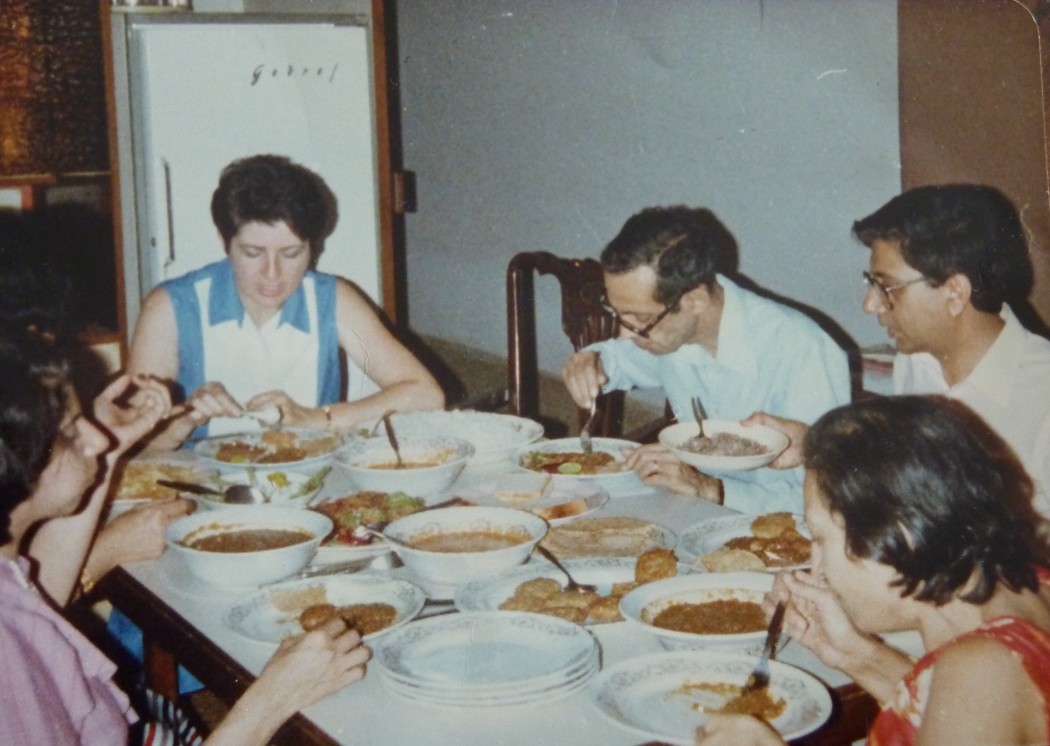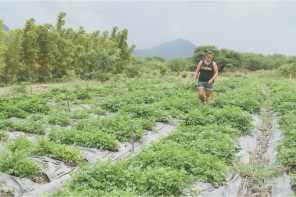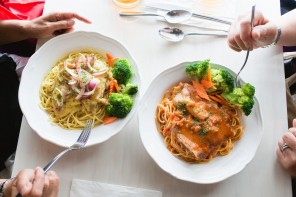The woman next to me at the Vietnamese stand sent her food back because there was no curry powder in the curry. I wanted to say, I never put curry powder in my curry. I know nothing about making Vietnamese curry. In my curry, I use fresh garlic and ginger, cumin powder, and a dash of cinnamon. Curry powder in curry reminds me of college, where we used potent spices to overpower college budget food—pasta bought on Safeway sale, yellow kale, ramen noodles, and canned tomatoes. I almost told the woman about how I learned to cook curry from my mother who recorded the recipe from my grandmother. I wanted to explain that how I feel influences the way I cook, unlike my mother who follows the recipe with measured precision. But I didn’t say any of this. I sipped my pho enjoying the lime and cilantro—the perfect blend.
When I first started cooking, I was in college. I used curry powder on tofu and eggs. I added every green herb I had to pasta sauce until my food tasted like something rolled through the spice cabinet—a big glass of water was needed to swallow it down.
I lived in Santa Cruz then, where being Indian was glorified but not understood. How cool you’ve been to India?! Did you go to an ashram?
It’s a lot of things, I would say. Not all elephant rides and curry powder. My favorite dish to eat when I visited India as a kid was puri bhaji. There was something illicit about having fried bread and spiced potatoes for breakfast, like a tricked everyone into believing it was dinner. I loved popping the puries, letting all the hot air sizzle out of the balloon like bread. The potatoes were yellow with turmeric that leaked onto my fingers.
My family centered on eating. I developed my palate at a young age. This, eventually, would lead me back to the truth.
But there was the year when my vegan roommate “harvested” pumpkins (aka almost rotting Halloween discards) as his contribution to the household food supply. I cut up the pumpkins, steamed them, and seasoned them with curry powder. Curry powder is a western concoction of spices invented by the British who wanted to bring some cuisine back home. A one size fits all mix of spices to make any dish taste like India.
Back in college I did not realize that curry powder was a colonial invention anymore than I realized that the legacy of British colonialism was the partitioning of south Asia into India and Pakistan. A blood bath that led to the largest land migration in human history–about a million people died.
I was born in America, my father was born in India, and my mother was born in Germany. Halloween pumpkins with curry powder was my culinary fusion. The grainy flesh, the overpowering perfume of spices, a thin curry that washed over rice. We ate it for weeks. A watered down expression of cultural identity. The best place for that pumpkin would have been the compost. I should have toasted the seeds and called it a day.
My chicken curry remains a fusion: Grandma’s cuisine, Mother’s recipes, my kitchen. I use a hand blender to puree the tomato, coconut, and onion. There are no chunks, except for the chicken. Interesting, my mom says. I know that she misses sucking the meat off the bone. How could I ever make a curry without chicken bones?
I commit the sacrilege of making boneless curry. The curry is like a broth it’s meant to be imbibed with all the nutrients of the bones. The bigger the pot of curry, the more steps I cut out. I throw everything in a pot (garlic and ginger chopped coarsely), raw onions and chicken. I don’t even release the spices in oil. I just let it all marinate in the fridge and slow cook it on the stove the next day. Despite my mother’s warning to never overcook the chicken (I think this is bolded in her recipe with an exclamation point), I stew the chicken until it falls apart, flaking into the curry, thick with yogurt and coconut milk, pink from tomatoes.
It’s the simple, fresh ingredients that make the best combination. No amount of spice can cover the taste of chicken that’s not fresh. It’s the fat that divulges the age of meat.
On days that I cook leisurely, I do better. I carve up the chicken and pull off all the skin, trimming the fat. I heat the onions on low until they become translucent, and then add the spices, releasing the flavors in the oil. I pound the ginger and garlic into a paste with a mortar and pestle. Lentils were soaked the night before and cumin is toasted and set aside in a bowl. My daughters pull the cilantro off the stalk, leaf by leaf.
My mother didn’t have us in the kitchen. When I was in elementary school, I could do what I wanted after school, but dinner was served at 6 pm like clock-work. Being late to dinner was the worst of crimes. By 5:30 pm my mom was always at the stove, still in her work clothes—a silk suit, pumps, onyx and gold earrings tightly clipped. We set the table and cleared the dishes, but when she clicked on the stove, our best bet was to stand back. The onions hissed in oil and the steam cloaked her. Interruptions of any sort were not tolerated.

There were certain tasks that were relegated to me—peeling potatoes or licking the cream from the beater. Funny, I hardly ever peel potatoes anymore—all the nutrients are in the skin. But I do slice string beans at a diagonal angle just like my mom. They don’t cook right if chopped at a right angle. I always buy thick asparagus and peel the woody stalks. It wasn’t until I was a teen that I was trusted with peeling the asparagus—when I was careful enough to not shave too much off. Of course, I add my own brand to this tradition and even peel the stalk of broccoli.
My mom recorded the recipes of my grandmother on my father’s side who passed away before I was born, painstakingly typing them on a typewriter. The translucent paper is bound in a three ring binder and sits on my bookshelf between my Tartine bakery book and the Joy of Cooking. It is our family collection of Parsi dishes—descendents from Persia, the Parsis settled in India a bit before AD 1,000 (the actual date is somewhat contested). All that time we’ve retained our own unique dishes—heavy on meat and mild on the spice.
Traditions constantly reinvent themselves—my ancestors being no exception as they brought their roots from Persia to the humid landscape of Mumbai. I wonder what type of coconut milk my grandmother used. I refuse the canned milk. It is rancid half the time. I use a creamed coconut concentrate that I blend with water (back to the hand blender). Sometimes, I don’t add chili to the curry, not for any reason other than it’s not in the fridge. I don’t measure. It’s a dash of cumin, a pinch of salt, and a container of yogurt. My mom loads the ¼ tsp and brushes off the top to avoid any excess.
There are certain things that I will never be able to duplicate, like my mom’s garam masala. It’s her own unique mix of fresh, organic spices. I don’t put it in my curry or on tofu or in eggs. It goes in my daal, or on potatoes. Garam masala has its place. There are certain taboos that even I do not break, even though I make chutney with parsley once in a while (only because that is what grows in my backyard). My mom seals her spices in a glass jar because plastic corrodes. Sometimes I just open the jar and inhale. It is the perfect blend. And even when she gives me the recipe, I know I won’t ever quite duplicate it.
—Tara Dorabji
Tara Dorabji is a writer, arts educator, mother, and radio journalist at KPFA. Her work is published or forthcoming in the Tayo Literary Magazine, Huizache, Good Girls Marry Doctors, and Midwifery Today. Tara is working on her first novel, Before We Remember, which is set in Kashmir. Her projects can be viewed at dorabji.com.
RECIPES
CHICKEN CURRY for six
By Elena Dorabji
3 lb chicken, skin removed and chicken cut into pieces
1 large onion, size of baseball
1 cup canned tomatoes, chopped coarsely
1 tsp paprika
2 tsp ground cumin
1 ½ tsp ground coriander
½ tsp cinnamon
½ tsp ground pepper
½ tsp ground ginger [or use ½ in fresh grated ginger]
¼ tsp clove powder
1 dried red chili or ½ tsp of flakes
½ cup yogurt
6 or 7 oz. coconut milk
3-5 cloves of garlic, mashed
1 tsp salt, or more
six hard-cooked, peeled eggs
½ cup fresh chopped cilantro
Cut up the skinned chicken into smallish portions. Chop the onion finely, mash the garlic and grate the ginger, if using fresh. Into a deep-sided pot with a lid put the tomatoes, yogurt onions and garlic/ginger. On top place the chicken. Combine all the dried spices in a bowl and blend well. Sprinkle over the chicken. Lastly add the coconut milk. Cover and bring to a soft boil using medium heat, then lower the heat to gently cook the chicken until done, maybe 30 minutes. Stir once or twice at the beginning to keep the food at the bottom from sticking. Since the pieces are small and skinned the chicken will cook in less time. Don’t overcook because the chicken will keep cooking after the heat has turned off until you serve it. Taste for salt at this point. Too little salt makes the spices taste a little raw. You can assemble the dish even the day before but cook it at the last minute so that if tastes fresh for the meal.
Garnish with a half cup of chopped fresh cilantro but stir it in at the time of the serving. Plop into the finished curry up to six hard cooked peeled eggs, the smaller the eggs the better.
Serve with plain boiled basmati or jasmine rice.
[Traditional Indian cooking requires that the onion, spices and chicken be sautéed in a little oil first to soften the onions, fry the spices and seal off the chicken. One adds the items one after the other every few minutes. Once the chicken has fried a little and become coated with spices and onions, the rest of the ingredients are added the chicken is cooked, covered, until done.]
CHICKEN CURRY remixed
By Tara, daughter of Elena Dorabji and granddaughter to Nergis
3 lb chicken boneless thigh and breast cut up
1 large onion
1 cup canned tomatoes
1 tsp paprika
2 tsp ground cumin
2 tsp ground coriander
1 tsp cinnamon
a small chunk ginger
1 poblano pepper
1 cup yogurt
1 cup coconut milk (use packaged cream coconut and blend with water)
3-5 cloves of garlic, mashed
salt to taste
½ cup fresh chopped cilantro
Cut up the chicken. Dice the onion and pepper. Mash the garlic and ginger. In a pot fry the onion and pepper in oil on low heat until onion is translucent. Then add in ginger and garlic and other spices into the oil, be careful to not burn or brown (less than a minute). Throw in the chicken chunks, stirring often, but letting them brown a bit. Add yogurt, tomato and coconut milk. Bring to a boil, reduce the heat and let it simmer down at least an hour, mix occasionally. Scoop out the chicken pieces and puree the mixture with a hand blender adding salt. Add back the chicken and simmer until it flakes apart. Garnish with a half cup of chopped fresh cilantro at the time of the serving.
Serve with rice.





